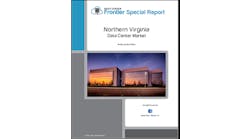The Data Center Frontier Executive Roundtable features insights from industry executives with lengthy experience in the data center industry. Here’s a look at the insights from Sean Farney, VP of Data Center Strategy for the Americas, for JLL.
As Vice President of Data Center Strategy for the Americas at JLL, Sean Farney helps clients operate more than 900 data centers sustainably and efficiently. Prior roles include: Director of Data Center Marketing at Kohler; Founder and Chief Operating Officer at edge data center startup Ubiquity Critical Environments; and data center manager for Microsoft’s 120MW Chicago facility.
Sean strives to embody sustainability personally: he hunts, grows, or harvests a majority of his food and burns deadfall to heat his home, earning him a county-leading Energy Star rating. He holds a master’s degree in Information Technology from Northwestern University.
Here's the full text of Sean Farney's insights from our Executive Roundtable:
Data Center Frontier: What do you see as the most significant ways whereby the unprecedented growth in digital infrastructure for AI and the cloud, and attendant core concerns surrounding power and sustainability, are giving rise to new paradigms for data center design?
Sean Farney, JLL: The revolutionary ways in which AI changes power and cooling are well-documented. We haven’t yet seen much marketing around the sustainability benefits of liquid cooling, but this is a great story for the industry, and I hope to see it promoted more.
I'm a champion of adaptive reuse as a proven strategy to address the constraints on digital infrastructure and sustainability.
There's an astounding 5 billion square feet of commercial real estate in the US alone. It's entitled, powered, cabled and located in virtually every demographic area.
Combined with a modular solution, adaptive reuse offers unparalleled time-to-revenue, ultra-low PUE and carbon circularity.
And the industry is really good at repurposing industrial assets for data center use: 350 Cermak, 60 Hudson, One Wilshire and 529 Bryant Street are some of the most storied facilities in the business.
I challenge the design/build folks to reconsider this old-school type of recycling.
Data Center Frontier: Is the data center industry approaching a similar inflection point for the expansion of edge and prefab modular facilities to meet hyperscale capacity and compute demands, as it did last year with the expansion of data center rack power densities in wholesale and colocation facilities, in response to the wave of heightened expectations for generative AI and liquid cooling stakes?
Sean Farney, JLL: Well, I'm a little biased because I founded a startup 10 years ago based on the premise that the edge would break out imminently! But I do think that many of the preconditions are right for a surge in facilities located in non-Tier 1 cities.
There’s a growing supply/demand imbalance exacerbated by deep-pocketed hyperscale developers who have effectively cornered the market on large sites. We also see a surplus of industrial and commercial assets available for adaptive reuse and a corresponding slate of board-level sustainability mandates encouraging such carbon-reducing circularity.
Finally, myriad new modular offerings from Compass Quantum, Vertiv, Schneider Electric and others have come a long way since the early days of shipping containers full of servers.
That said, I don’t think hyperscalers will necessarily drive commercial edge development. With vast internal portfolios of edge sites, they're already there. Instead, customer needs will propel growth.
First, there’s the continued growth of content distribution needs where the bits must be close to the consumer — think streaming media, health and safety, autonomous vehicles and virtual reality.
Second, at JLL we are getting inquiries from enterprises that need AI capabilities for product development or test/dev/lab environments and, for a variety of reasons, want it on-premises. Since most of these facilities cannot support AI's technical demands, we see an emerging opportunity for AI-specific modular environments that leverage companies’ acres of underutilized parking lots and new modular solutions.
In closing, I'd say that if the “edge” is Tier 2, 3 and 4 MSAs, recent announcements about huge new projects in Wisconsin, Iowa, Michigan, Ohio, Utah, Nevada and other non-traditional markets may very well prove that it’s already here.
Data Center Frontier: Is data center operators’ level of short-term investment keeping pace with the level of hype surrounding the range of data center liquid cooling technologies; and if not, when do you think the industry will see these vectors converge?
Sean Farney, JLL: Absolutely — I'm working with clients across all segments and sectors, researching and testing new cooling tech to handle the extreme challenge of AI's exorbitant cabinet densities.
The industry is pursuing solutions at a frenzied pace, from rear door heat exchangers to direct-to-chip and immersion. We just don't yet know which solution will ultimately win. But we must move ahead, not letting the fear of the unknown "how" stop us from pursuing the known "what."
Although (understandably) scary to critical environment operators, this unknown is exciting and driving incredible Create Destruction. I haven't seen this type of energy, mission and friendly competition since the early days of power utilization efficiency (PUE) gamification 10+ years ago.
So, operators are, by design, taking a short-term, tactical approach to technology selection before going all-in and making strategic investments in replacement cooling tech because they know it's a growing part of their value chain going forward.
Now, it’s possible that over the next three years, we will see one of the solutions establish dominance. However, based on what our clients are doing, I suspect that the prevailing model will be a hybrid of multiple cooling technology derivatives — both air and water — that addresses different densities and heat loads in the same facility.
I say this because we have GWs upon GWs of installed technology that can continue to serve traditional densities. We also know that even deep-pocketed hyperscalers are not building 1,000,000-square-foot facilities dedicated exclusively to AI computing, because it is not yet hyperscalable.
Data Center Frontier: To what degree do you see larger projects and heightened demand exacerbating challenges with North American supply chains and delivery timelines for data centers in 2024, and to what degree do you see creative partnerships, mergers, and acquisitions potentially helping to alleviate such obstacles?
Sean Farney, JLL: Collaboration is essential to delivering new data center projects in today’s environment, where the combination of highly constrained digital infrastructure, voracious demand and a long backlog of large capital items has created an extended supply/demand imbalance.
For example, JLL recently partnered with Schneider Electric and Lumen Technologies on a modular solution to deploy scalable, sustainable and on-net facilities at thousands of existing sites. The partnership leverages each player’s strengths — JLL's in real estate, Schneider's in design/build and Lumen's in connectivity — so the team can deliver projects in months instead of years, creating value greater than the sum of the parts.
I'd even venture to say that we are moving into a period when coopetition (strategic alliances between competing companies) will be what defines the most successful players.

Matt Vincent
A B2B technology journalist and editor with more than two decades of experience, Matt Vincent is Editor in Chief of Data Center Frontier.





